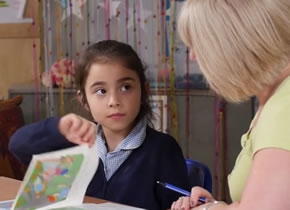8th March 2016 - Getting to grips with comprehension
Struggling readers generally have difficulties with both elements of the reading process:
- They are not competent at word recognition.
- They often fail to make sense of what they are reading.
Improving their word decoding skills will be beneficial, but struggling readers who have to sound out a high proportion of the words in the text are interrupting the flow of fluency upon which comprehension depends. Added to that, they usually read so slowly that what they hear themselves say does not sound like meaningful language. And, of course, many struggling readers adopt their favourite strategy when faced with an unfamiliar word … they wait to be helped by the supporting adult! So, something has to be done to reduce the ‘stop/start’ nature of their reading style which has such an impact on comprehension.
And that’s where Prepared Reading comes in!
Prepared Reading is a teaching technique in which the supporting adult ‘tunes in’ the learner to what the text is about by looking through the book before the learner starts reading independently. This gives the learner the ‘big picture’ of what the text is about. And that’s important because most struggling readers have limited story/text experience. They do not have much sense of narrative and their prediction skills are often shaky. But if the adult regularly shares a brief overview of the text (or part of a text in a longer book) before the learner starts reading, then the learner becomes familiar with how texts work.
But Prepared Reading does more than that …
It also gives the supporting adult the opportunity to introduce any more challenging vocabulary that is specific to that text that the learner might struggle to decode or even understand. Imagine a non-fiction book about lions. The struggling reader might use their decoding skills to tackle ‘cubs’ and ‘Africa’ and even ‘pride’ but they may be flummoxed by ‘territory’ and ‘wildebeest’. Nobody would be surprised that a struggling reader would hesitate over those words. But the adult faces a dilemma – do they …
- let the learner try to work out what the word is (which probably won’t end up with the word being read accurately)
or
- tell the learner what the word is (and reinforce the idea that the learner is dependent on the supporting adult for some of the words in the text)
Neither of these options are great for comprehension or reader morale!
But if the adult has used the Prepared Reading technique, then the learner will have heard and seen the words ‘territory’ and ‘wildebeest’ in context and will know what they are when they come across them when reading. Nobody is pretending that that means they can read those words should they arise in a different text at a later occasion. But, to be honest, on the scale of ‘need to know’, the words ‘territory’ and ‘wildebeest’ come quite far down the list of priority words to recognise. What matters is that those words do not interrupt the flow of reading, so that the learner can concentrate on using their decoding skills to read the more manageable words in the text, such as ‘cubs’ and ‘Africa’ and ‘pride’.
Prepared Reading and Catch Up®
Because we know the benefits of Prepared Reading, we have made it an integral part of the
Catch Up® Literacy procedure. So we start each 15-minute one-to-one session with 3 minutes of Prepared Reading, where we focus on comprehension and unfamiliar vocabulary, and then we move on to support the learner in their use of decoding strategies when they read aloud to us.
So, to sum up about Prepared Reading…
- The learners have the ‘big picture’ of what the text is about before they start reading independently.
- They have no anxieties about unfamiliar vocabulary.
- They have a purpose for reading the text.
- They start reading with confidence.
- This confidence means they read at a faster pace.
- Reading at a faster pace means they concentrate on reading for meaning.
Once you’ve tried it, you’ll want to use it all the time – not just in
Catch Up® sessions – because it has so many benefits. Perhaps my favourite reason for using it is that it is so helpful for the learner but they don’t even realise they’re being helped and, for the struggling learner who is always having to ask for help, that’s a real bonus.
Dee Reid,
Catch Up® Co-creator and Consultant

